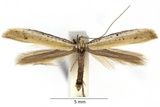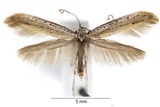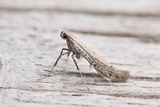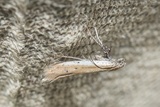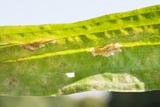Aspilapteryx tringipennella (Zeller, 1839) Species
Last modified: Dec. 14, 2024, 11:05 a.m.
An uncommon species in Belgium, occurring in scattered populations all over the country.
Details
- Classification
- Family: Gracillariidae > Subfamily: Gracillariinae > Tribus: Gracillariini > Genus: Aspilapteryx > Species: Aspilapteryx tringipennella
- Vernacular names
- Weegbreesteltmot (NL), Ribwort slender (EN), Wegerich-Miniermotte (DE)
- First mention in Belgium
- De Fré Ch. 1858. Catalogue des Microlépidoptères de la Belgique. — Annales de la Société entomologique belge 2: 45–162. On page 146 (as fringipennella). view page
- Status
-
Native
Distribution
Caterpillar
The first instars have the same color as the plant tissue light green. In the last instars, the caterpillar gets a greyish-brown color with a dark brown head capsule.
Mine
The mine starts as a small, gallery leaf mine on the underside of the leaf, but later instars eat their way to the upperside of the leaf, causing a blotch mine in which they spin many threads causing the leaf to fold strongly.
See also gracillariidae.net and bladmineerders.be.
Cocoon/pupa
A pure white cocoon.
Bionomics
The caterpillars of the second generation hibernate. Pupation takes place in the mine, inside a pure white cocoon. The adults are attracted to light.
Flight periods
The adults fly in two generations a year from late April till late May and again in August.
Observed on
- Host plant (species):
- Plantago lanceolata and Plantago maritima
The larvae feed on Plantago lanceolata, but can occasionally also be found on Plantago maritima.
